The Decline of Western Title Sequences
What passes for modern film critique today leaves much to be desired. In the instant case one "Carles" a "Staff Writer" for Grantland and founder of the "authentic content farm," "Hipster Runoff," (no, really) felt the irresistible urge earlier today to pen "Post-Empire Thinking," a review of the most recent, and third, season of HBO's original series "Boardwalk Empire." Just by way of context, "Hipster Runoff" describes itself thusly:
HIPSTER RUNOFF is a blog worth blogging abt, created by Carles that is trying 2 stay relevant. It blogs abt buzzbands, alt_stuff, and memes.[sic]
Perhaps we are going out on a limb, but we suspect that, aside from the entertaining title, Hipster Runoff might have escaped the notice of the always discerning finem respice reader. Such would have been its fate with finem respice as well if not for the jarring and hopelessly ignorant prose purporting to review Boardwalk Empire as a series and, more importantly, the title sequence thereof.
"Carles" opines:
Boardwalk Empire opens with a one-minute, 33-second title sequence before every episode. Steve Buscemi's character, Nucky Thompson, stands on the beach of Atlantic City as he watches thousands of bottles of alcohol emerge in the waves. He glares with anger and gazes in deep thought, then walks toward an illuminated Atlantic City as modern rock music plays. For the first two seasons, I would get angry watching just five seconds of those credits, wondering how it fit with the show, what it even remotely symbolized. For years, I tried to string together a theory that the show as a whole would be perceived differently if that title sequence were abstractly accessible in a Mad Men–y kind of way, or even a more generic montage of cast members.1
Our interest in this obscure bit of writing and critique stems from the fact that, contrary to myriad assertions of "Carles," the opening sequence to Boardwalk Empire is among the most exceptional, brilliant, and apropos openers that has found itself front-running for a one hour drama. It is nearly inexplicable that an author with just cause to hold himself out as a critic would fail to pick up on the many, multi-faceted, and multi-layered themes, conflicts, and narratives so wonderfully and succinctly played into a mere 90 seconds.
But his misunderstanding of the series runs much deeper and is easily mistaken for a fundamental ignorance of history, and narrative progression. Then again, perhaps it is simply the result of the Adderall-addled cognitive deficiencies that plague the late-20somethings (however old they are in calendar years) of this latest half generation.
In wishing for a title sequence that was instead "abstractly accessible in a Mad Men–y kind of way, or even a more generic montage of cast members," "Carles" exposes the worst kind of viewer apathy. The kind of mentality that yearns for the bold and risky storytelling of the title sequences of the Law and Order series.
Or the blunt intellect that finds more accessible the simplistic animation of Mad Men's opener (he is overwhelmed by advertising, falls through a forest of advertisements and then ends up, relaxed, smoking, in his chair!)

One can only assume that the state of primary, secondary, and university education in the jurisdiction from which "Carles" hails is even more sub-par than normal. Simple concepts (like basketball, Rihanna, and the Law and Order title sequence) are the most easily absorbed and processed.
Little wonder, really, that the title sequence from Boardwalk Empire is confusing, frightening, and new. To wit:
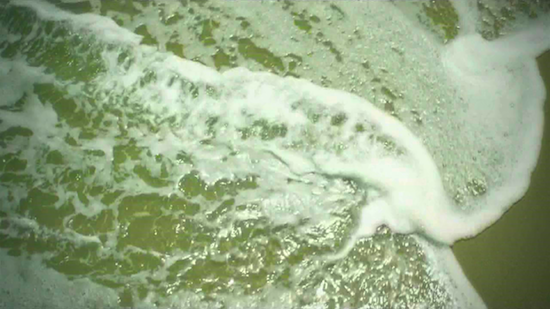
The sequence begins with a bird's eye view of the frothy surf of what is obviously salt water. Later we learn it is the Atlantic Ocean. But, unlike almost every other ocean sequence, the wave recedes, revealing Steve Buscemi's name in the sand as it wipes from right to left.
The reversal of the normal time order we see the sea following in film is a message. This is a reversion. This is the past. It is in retrograde. It is... retro.
As the water pulls back, the sand goes from soaked, to wet, to dry, a wonderful metaphor for a drying out. It is the beginning of prohibition, a key (the key) plot element in the series. The name of the lead character, a beneficiary of prohibition, is revealed by the retreat of the water, by the drying out. A small-town mayor who would likely have never amounted to anything but for the drying out (in the title sequence, the drying sand). His opportunity, greatness, and moment in the sun means he is only revealed as a figure of note as the earth around him dries (prohibition becomes the law of the land). As his name is revealed the sequence shifts to slow motion, highlighting the fact that we are focusing on the period as the water is just receding (the early years of prohibition- and the times in which the greatest opportunity and the most severe conflicts would be set).
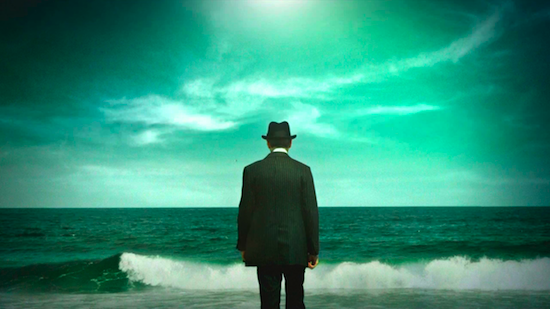
The shot cuts to a rear view, wide shot of Buscemi walked towards what is now obviously a large body of water. He is perfectly centered in the shot, though his legs are cut off just above the knees. He is dressed in a 1920s suit and topped with a homberg. In front of him the waves crash towards him, above him there is a blue sky stroked with wispy cirrus clouds. Because in the shot the water's edge is not visible on the bottom border, the audience is immediately and tactically aware that their hero is either standing in the water, or that it threatens to crash over his feet. Dressed as he is, this strikes one as just slightly difficult to watch. Immediately, consciously for the film critics among finem respice readers, unconsciously for everyone else, one develops a certain concern and sympathy for our hero. We are curious why he appears to willingly wade into the surf in his best suit. Adding to the tension is the casual manner in which he strides towards the sea. His movement is deliberate, measured, confident, and inevitable.
The names of the co-stars begin to appear. Kelly MacDonald (our hero's love interest and wife) appears above in the clouds. Michael Shannon (an anti-hero or perhaps a villain, depending on the season) is, as with Buscemi, revealed from bird's eye by the receding surf and drying sand (another character who would be a nobody but for prohibition).
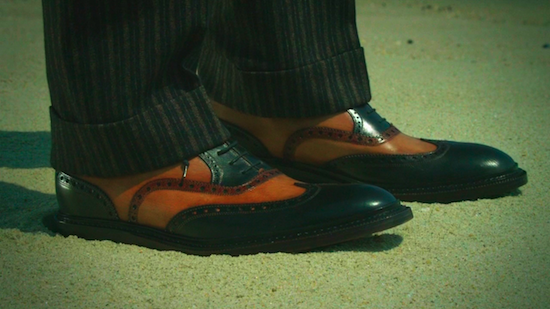
Then, just to emphasize the peril of the rolling surf, the sequence cuts to a landscape shot of Buscemi's feet, clad, setting the era wonderfully, in two-tone, full black and tan brouge, pant-legs of his impeccable pinstriped suit-pants (there is not a grain of sand on them or the shoes) cuffed a full two inches, falling across the shoes at nearly the perfect length (just a hint of lace below).
The contrast of the white-yellow ocean coral sand his heels are sinking into and the flawless state of his attire emphasize the enduring conflict to come: This is a man for whom appearances are important, regardless of the circumstance. There is an almost british "stiff upper-lip" quality to his defiance of the sea, the sand, and his willingness to stride out onto the beach clad in his best clothes. Or perhaps, he is never caught without the armor of his gentlemanly appearance, no matter the environment? Whatever his motivation, it is clear he is treading onto soft ground, into uncertainty, chaos, and that he is willingly exposing himself to danger (the churning sea and the surf that boils towards him).
It is no accident that this part of the title sequence perfectly follows the classic three-act structure (beginning, middle, and end for the Aristotelians among finem respice's always erudite readership). Literally, almost everything we need to know about our hero is played out in the first eight seconds of the sequence. We know the period in which the story takes place by the cut and pattern of our hero's suit. We know he is a man of means by the expensive appearance of his clothes and shoes. We know he is willingly walking into danger and conflict, and that this deliberate assumption of risk will put him on unsteady ground. And we know that he sees the conflict, the change (and the opportunity) that is represented by the sea (because he faces it head on and walks towards it). The amount of narrative information compressed into this sequence is dazzling, and wonderful. (But then, how is one surprised by this? Martin Scorsese directed the pilot episode and acts as Executive Producer for the show). We invite interested finem respice readers to watch the first five minutes of Taxi Driver, Raging Bull, Goodfellas, or Casino to understand the deliberation that clearly surrounds the first eight seconds of Boardwalk Empire every week.
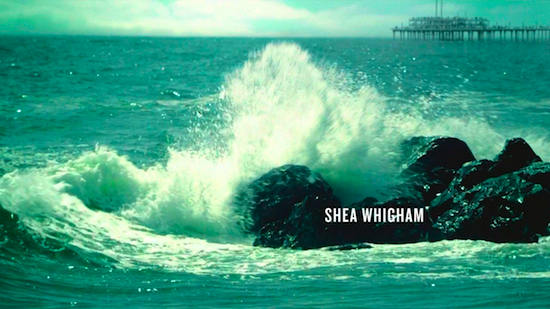
But the conflict will escalate. And, as such, the sea begins to grow angry. First, only depicted by reference to shore-side rocks, over which boiling seas crash. For American viewers, the pier in the distance suggests the east coast, the Atlantic seaboard. For north-easterners the whiff of New Jersey is already in the nostrils:
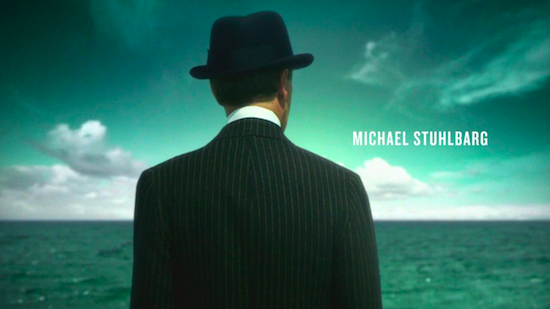
The pace of matters picks up. The once stationary clouds are in time-lapse now, driven by unseen forces into the shore, into our hero, whom we now see closer (though still from behind). He is difficult to approach, hidden, and ignores all appeal to reason as he faces the volatile sea even as the winds and the skies hint at anger and danger. His head turns from right to left, surveying the horizon, or some distant landmark, or merely searching for something out in the chop and foam.
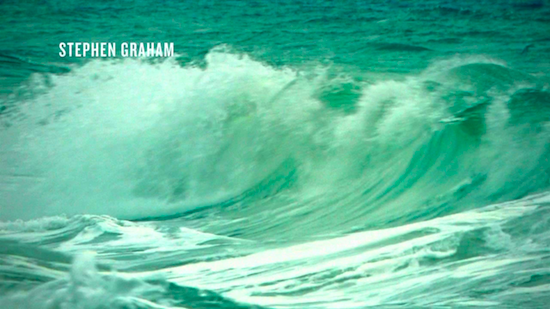
The sea is decidedly angry now. The surf rolls, and boils with foam. Things will get ugly.
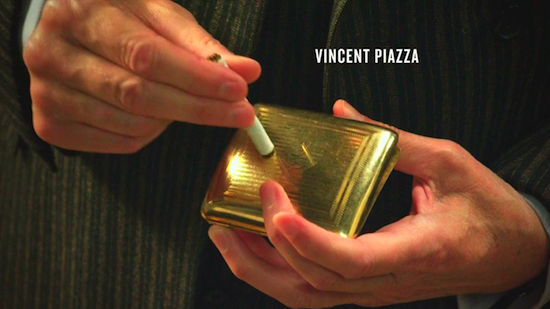
Our hero measuredly pulls a monogramed gold cigarette holder from his inside, breast pocket. Another reminder of his wealth and power, but also a reminder of the absurdity of prohibition. He can, after all, openly smoke tobacco. But even the churning of the sea does not shake him. He slowly and deliberately "taps down" his cigarette, turning it over and over in his fingers as he watches the sea calmly.
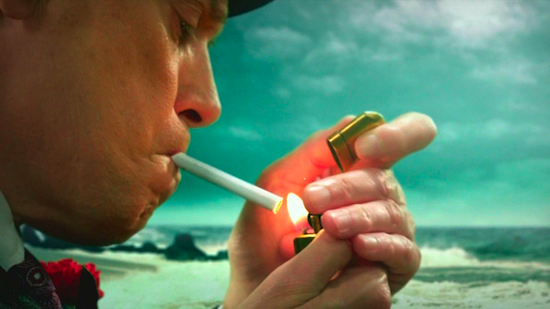
By the time we cut to the lighting of the filterless cigarettes, the first glimpse of our hero's face, as it happens, and also a slice of the red carnation in his buttonhole, his dark red tie, the sky is a blue-slate grey with clouds, the surf continues to churn in the background and the weather is turning decidedly foul. Fire is introduced. The wick is lit.
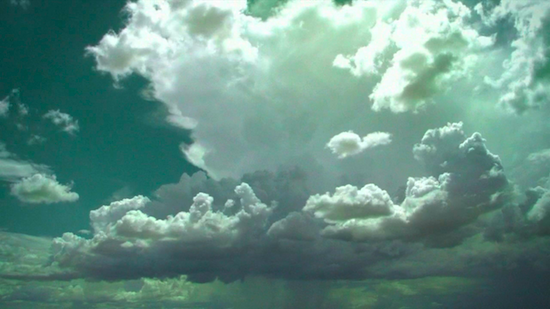
It is not only the sea that boils now, but also the sky. Rain and virga visible in the distance, approaching. The proverbial dark clouds on the horizon. Trouble is brewing.
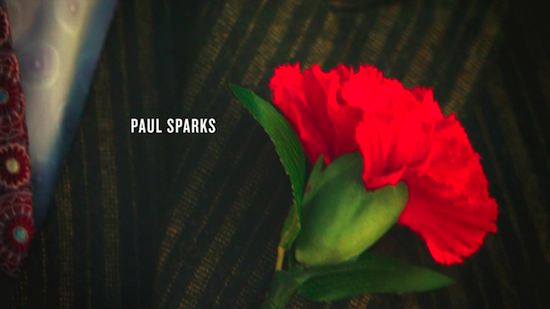
And our hero will answer it in blood. The bright red blood spilled in battle, as of his carnation, and the dark, aged blood of loyalty and family, as on his tie.
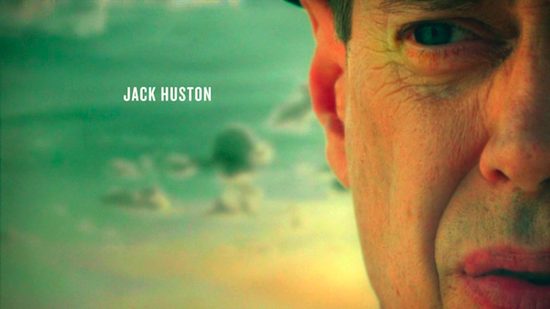
We are then confronted with the hero's face, but cut in half. A measure of his duality, the hidden and repressed elements of his character. The smoke he exhales blends with the rushing sky behind him. He too will contribute to chaos and change.
Then... a transition...
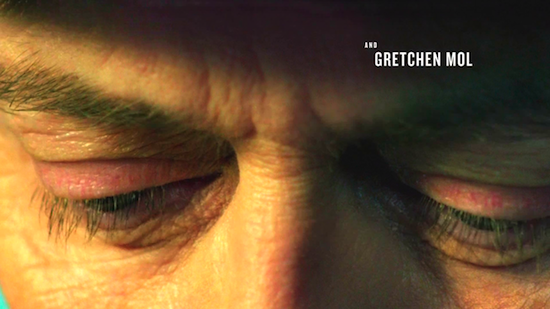
His eyes first downcast... a blink...
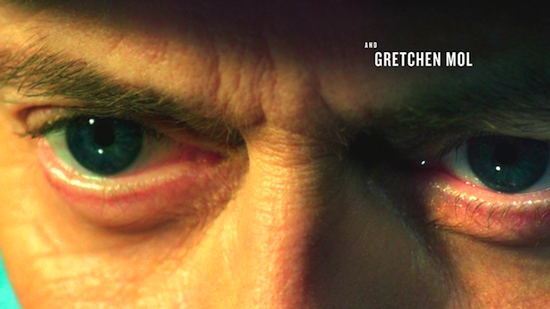
...and then lifted to the horizon, now big, blue, bright and open...
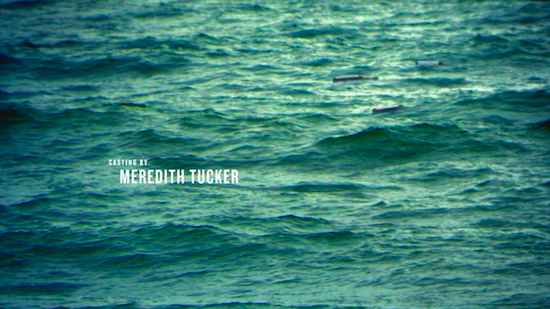
...out to the sea, and the first signs of floating bottles... just a few, bobbing in the waves.

A closeup reveals them, sloshing in the chaos of the sea: Canadian Whiskey. Bootleggers.
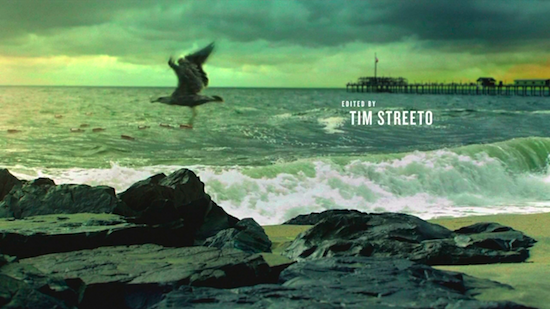
And then a wide shot, seagull taking off, as if startled. In the background, about a dozen floating bottles. The sky is an angry dark grey and orange now.
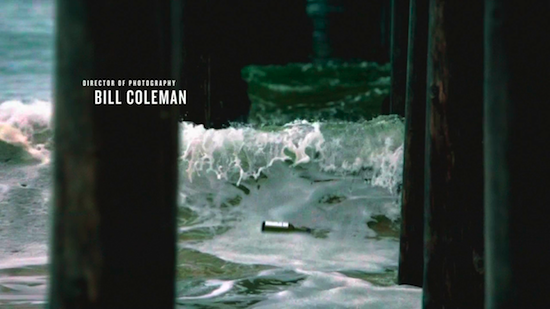
And now the bottles are headed ashore. Beneath the pier, hidden, where the surf crashes angrily between timbers.
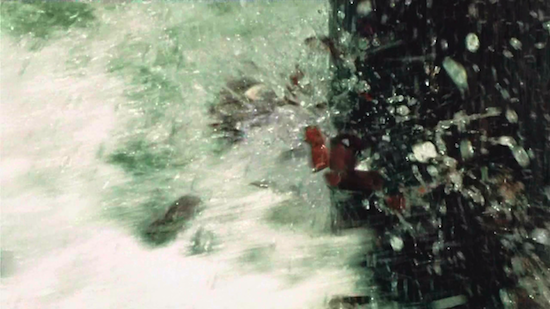
And now... the break. The themesong drops out of its steel guitar intro into an angry refrain as bottles of canadian whiskey smash against the pylons of the pier, shattered glass flying in all directions, churned by the force of the surf. There will be losses. There will be... breakage.
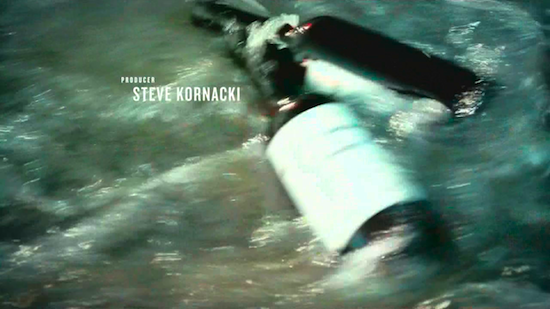
But some wash ashore. Safely, in quieter, lapping waves.
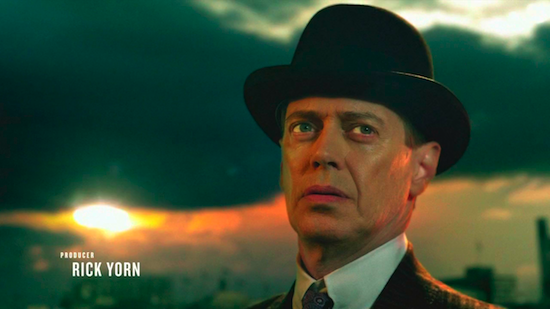
Our hero's mug is the center of an angular pan, behind him the sun is slowly revealed from behind the clouds, just above what is now obviously Atlantic City. Chaos and strife be damned, our hero will endure.
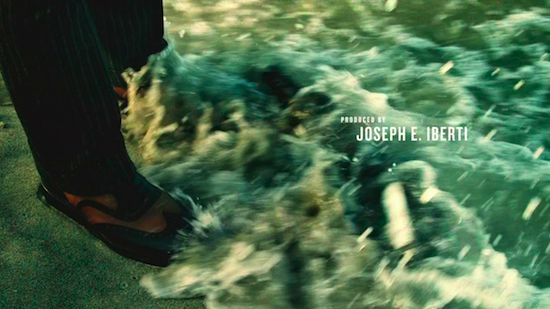
His shoes might, indeed, get wet, but the chaotic sea will deliver whiskey bottles to him and lay them at his feet.
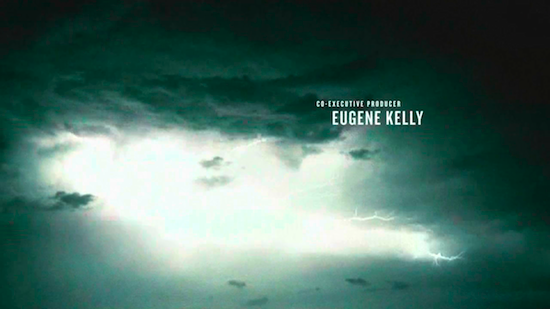
And as things escalate, and more and more whiskey is in the water, storm clouds form, lightning strikes, the sound of thunder echoes.
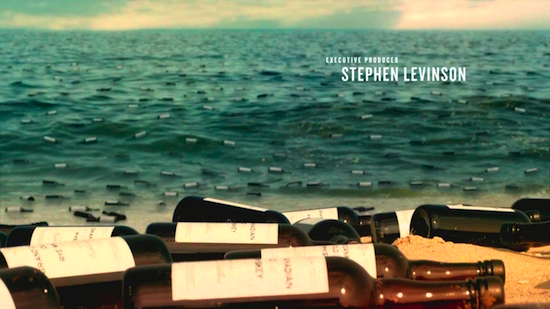
But this is big business. Everyone is on board. The booze will find a way, and, like driftwood, come ashore en masse.

And our hero knows it....
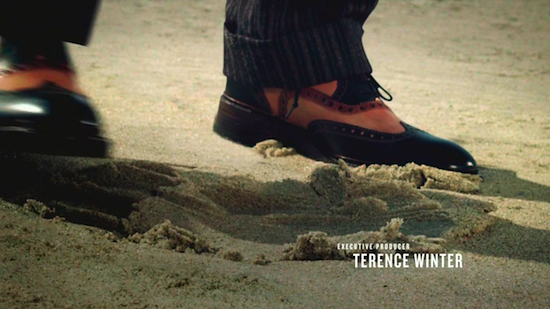
...wet socks? Worth it.
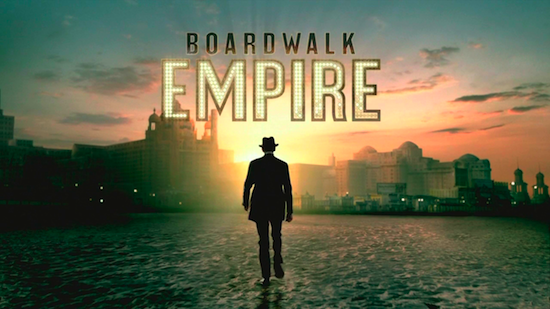
But, well, maybe you prefer:
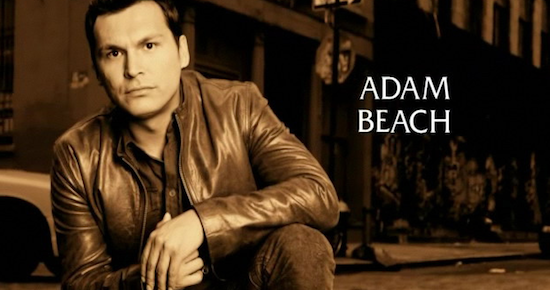
...a montage with the characters striking poses like they smell something on the set.
Whatever.
- 1. Carles, "Post-Empire Thinking," Grantland (November 30, 2012).
Entry Rating:
